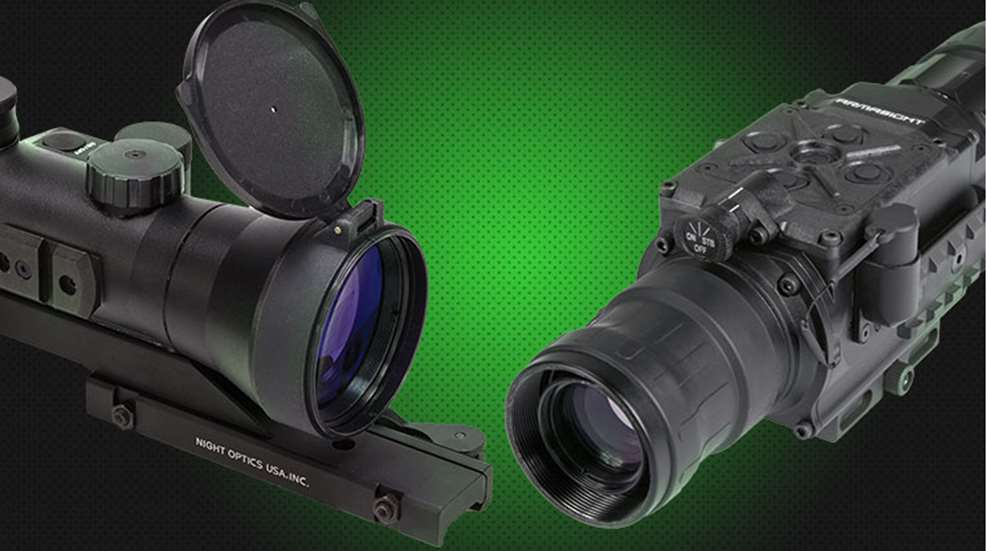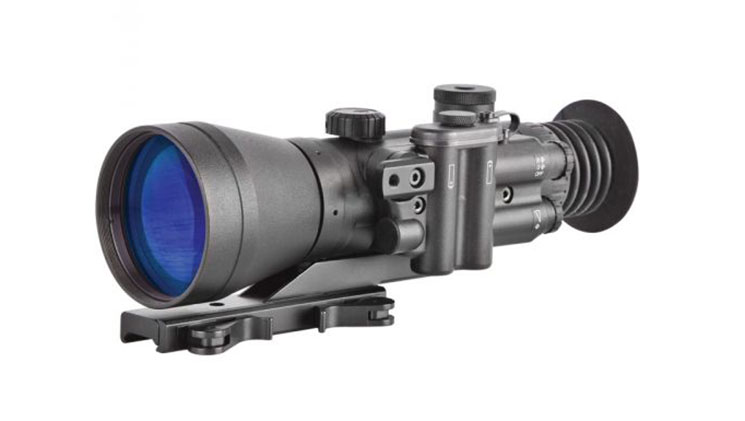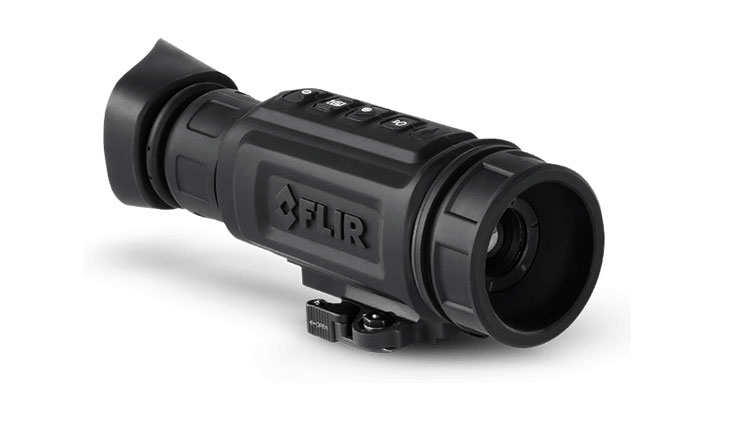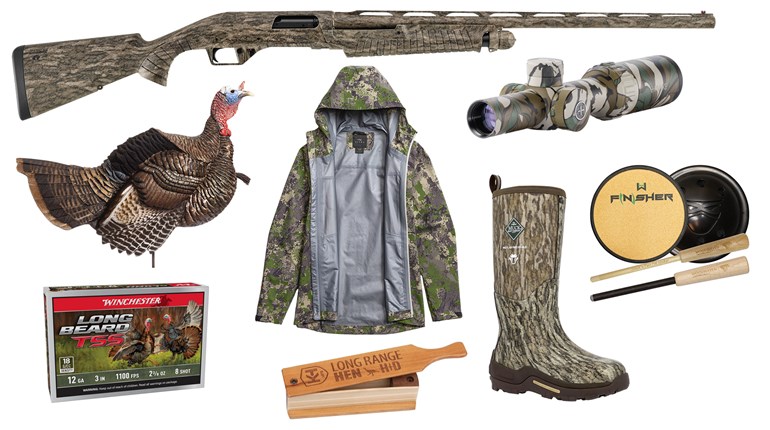
For most hunters, when the sun sets, the hunt ends. For others—those who chase the sounds of oinks and howls—the hunt is just beginning. When you hunt at night, you have to be able to see in order to be safe and successful. For decades, the only choices for night hunters who wanted to see beyond the capabilities of the naked eye were hand-me-down military-grade night-vision optics using light-intensified technology, or the quick draw of well-placed shots on legally spotlighted nuisance animals like pigs, coyotes and raccoons.
My, have things changed for the better—unless, of course you taste like bacon or have an unhealthy roadrunner addiction. Today’s hunters have a wide array of choices in both light-intensified optics (those that utilize ambient light or infrared light to intensify an image) and thermal optics (those that detect and display radiation and heat contrast to the surroundings) to help them see their prey when the lights go out. Which technology works better, though, is more of a debate than many may realize because both optic technologies have their strengths and weaknesses.

Light-intensified Optics
Light-intensified optics—which is what most folks think of when you say “night vision,”—takes whatever light there is, however slight it may be, and magnifies it with what is known as an intensifier. The technology works, and in many ways is superior to thermal optic technology.
“The advantages of a night vision device is that it provides a real-life, real-time image in low-light situations,” said Rolando Petit of Night Optics USA, Inc. “For some, having that more natural viewing experience is preferred.” What Petit is talking about is the fact that the image light-intensified optics give hunters looks quite similar to what they would see through a daylight optic—meaning a pig looks like a pig, a coyote can be identified over a fox or even a farmer’s faithful sheepdog. In fact, outside of the sportsman’s realm, night vision optical technology sees heavy use in tactical applications because of its threat recognition capabilities, according to Petit.
“In law enforcement, night vision is an important tool for detection, recognition, observation and perimeter control,” said Petit. He added that he feels thermal optical technology is great for detection but for legal reasons should not be used for engagement without first verifying subject identity with recognition. “Thermal is gaining popularity in law enforcement, but given the high importance of recognition, night vision is still the preferred solution.”
Like most technologies, in the early days of light-intensified night vision, getting anything close to usable imagery for the average hunter required a financial planner and maybe a few winning lottery tickets. Over the years though—thanks to trickle-down technologies made possible by significant advances in military and commercial light-intensified night vision capabilities—hunters can operate at night, at least visually, without breaking the bank.
Night vision goggles, a monocular, binoculars, riflescopes and even still and video cameras enable hunters to see, detect and engage their prey at night as well as their budgets will allow. Still, despite the advancements in light-intensified optics technology, it has inherent disadvantages compared to its heat-sensing alternative. “Night vision is dependent on the amount of ambient light available,” said Petit. “If there is little to no moonlight or starlight, an IR illuminator (think night vision flashlight) will be required.”
Bottom line, light-intensified optics work and are relatively affordable these days. Still, Petit has words of warning for optics-hungry hunters. “Buyers should beware. Cheaper is not always better. Doing your homework before making such an investment is paramount in ultimate user satisfaction. Sometimes ‘cheaper’ night vision means that a lower quality image tube was used. The image intensifier tube is the most expensive component and the heart of what makes the night vision device work. What sets one scope apart from the other is always going to be the quality of the image tube, as well as the optical glass and coatings technologies.”

Thermal Optics
Another way to see in the dark—even on a limited budget—is by using optics engineered to sense heat instead of reflected light, known commonly as thermal optics. Heat is different from light in the sense that it always exists to some degree (no pun intended), regardless of the time of day or night. It’s also everywhere.
“Thermal energy comes from a combination of sources, depending on what you are viewing at the time,” said Haley Ellison, public relations manager for FLIR Systems, Inc. “Some things—warm-blooded animals, engines and machinery, for example—create their own heat, either biologically or mechanically. Other things—like land, rocks, buoys and vegetation—absorb heat from the sun during the day and radiate it off during the night.”
The advantages of thermal versus light-intensified optics is, well, clear. FLIR Systems said thermal imagers don’t have any of the shortcomings of visual light cameras. “First, they have nothing to do with reflected light energy—they see heat,” said Ellison. “Everything you see in normal daily life has a heat signature. This is why you have a much better chance of seeing something at night with a thermal imager than you do with visible light camera, even a night vision camera.”
The Verdict
I recently had the opportunity to use both light-intensified and thermal weapons optics during a wild-hog hunt in Florida with C&H Precision Weapons. Co-owner Buck Holly, a weapons expert for the U.S. Marine Corps and a member of Remington’s Pro Staff, put me in both ideal and degraded situations for both technologies. My experiences validated all of my quoted experts opinions, with swine falling repeatedly to my Remington M40A1 replica 6.5 Creedmoor, topped with a FLIR Systems, Inc. ThermoSight R-Series riflescope in near-dark, complete dark and visually-distracted shooting situations at distances from 25 yards to more than 125 yards. In fact, my largest pig fell on a thermal-aided spot and stalk when light-intensified optics were useless due to extremely low levels of ambient light.
The debate of light-intensified versus thermal optics goes on, but with proper knowledge of your environment, range and budget, hunters have plenty of choices, which could ultimately include using both technologies in tandem.
“While Night Vision is a tried and true solution for hunters, both technologies work hand-in-hand and each can be used independently or together to yield the most optimal result,” said Petit. “Every hunter has his or her preference but there is a benefit to using both. Thermal can be used as spotter for detection, while a high-quality night vision riflescope can be used for target recognition and engagement, or vice versa the night vision device can be used for detection and recognition, while the thermal scope or clip-on can be used to track and engage the target.” Petit recommended hunters on farmland with farm animals or in area’s where pets may be present use light-intensified optics, because the technology enables proper animal recognition.
Still, affordable is a relative term. Petit cautioned hunters with both deep and shallow pockets. “Both night vision and thermal imaging have gotten cheaper over the years but are still expensive technologies. Make sure there is a return policy, read reviews and seek opinions from others.”
Both technologies work well, but you have to set them up for success. When you have some light and favor positive target identification, light-intensified optics can be a good choice. If you doubt your ambient light availability and favor detection over recognition, then it’s tough to top the 24/7 technology of thermal optics.
In the meantime, like all technologies, both optical systems will continue to evolve. Petit leaves all hunters with these final thoughts: “Systems will continue to get smaller, lighter, faster and hopefully cheaper. Night vision also continues to evolve. New glass, coatings solutions and smaller devices are integrated technologies that keep the industry going and growing!”





































